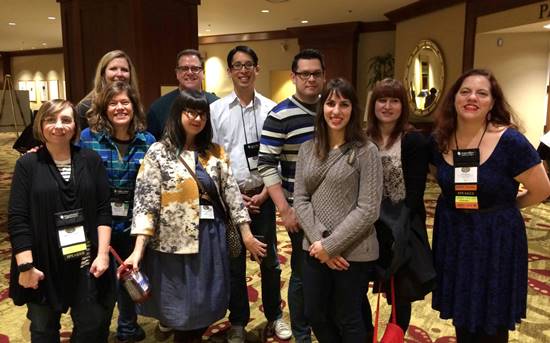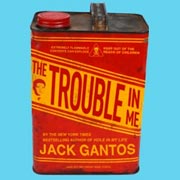Equal Parts Teen Services and YA Lit at 2015 YALSA Symposium
Librarian Robin Brenner highlights programs and events at the 2015 YALSA Young Adult Services Symposium, which took place November 6–8 in Portland, OR. This year’s conference widened its purview to include services and programming alongside literature, which was reflected in the theme, “Bringing It All Together: Connecting Libraries, Teens & Communities.”
 Librarians and educators who work with teens gathered for the 2015 YALSA Young Adult Services Symposium on November 6–8 in Portland, OR. This year’s conference widened its purview to include services and programming alongside its original focus on literature, which was reflected in the theme, “Bringing It All Together: Connecting Libraries, Teens & Communities.” This move added a range of content to the discussion and, according to preliminary figures, brought in an attendance of just under 500. Friday’s preconferences offered participants the opportunity to hear about three ways libraries are working to inspire and create extended communities. Each room was packed to capacity. Emily Burkot and Cara Williams, teen librarians in Cincinnati, OH, and Gregory Lum, library director of Jesuit High School in Portland, and I presented one afternoon session on how to build and connect communities through the use of graphic novels and comics in programs and classrooms and through connections with creators. Armed with plentiful practical advice, Williams and Burbot shared inventive, accessible programs and answered questions from the audience, such as how to locate recommended lists for middle school graphic novels. Graphic novelists Terry Blas, Leila del Duca, Faith Erin Hicks, Mariko Tamaki, and Gene Luen Yang weighed in with humor and insight on how social media has benefited and detracted from communities and the humility and respect necessary in writing outside your personal experience. Lum’s presentation on teaching Yang’s graphic novel American Born Chinese (First Second, 2007) explored how to tackle challenging questions around race, privilege, and history in the classroom. One significant highlight was hearing from three teen panelists, whose frank and articulate commentary on their responses to the text expanded into a thoughtful interaction with Yang and the audience.
Librarians and educators who work with teens gathered for the 2015 YALSA Young Adult Services Symposium on November 6–8 in Portland, OR. This year’s conference widened its purview to include services and programming alongside its original focus on literature, which was reflected in the theme, “Bringing It All Together: Connecting Libraries, Teens & Communities.” This move added a range of content to the discussion and, according to preliminary figures, brought in an attendance of just under 500. Friday’s preconferences offered participants the opportunity to hear about three ways libraries are working to inspire and create extended communities. Each room was packed to capacity. Emily Burkot and Cara Williams, teen librarians in Cincinnati, OH, and Gregory Lum, library director of Jesuit High School in Portland, and I presented one afternoon session on how to build and connect communities through the use of graphic novels and comics in programs and classrooms and through connections with creators. Armed with plentiful practical advice, Williams and Burbot shared inventive, accessible programs and answered questions from the audience, such as how to locate recommended lists for middle school graphic novels. Graphic novelists Terry Blas, Leila del Duca, Faith Erin Hicks, Mariko Tamaki, and Gene Luen Yang weighed in with humor and insight on how social media has benefited and detracted from communities and the humility and respect necessary in writing outside your personal experience. Lum’s presentation on teaching Yang’s graphic novel American Born Chinese (First Second, 2007) explored how to tackle challenging questions around race, privilege, and history in the classroom. One significant highlight was hearing from three teen panelists, whose frank and articulate commentary on their responses to the text expanded into a thoughtful interaction with Yang and the audience. 
Librarians and comics creators from the "Panels and Pages" preconference. Back row, l. to r.: Mary Karol Taylor. Gregory Taylor, Gene Luen Yang, Terry Blas. Front row: Jennifer Scott Wills, Mariko Tamaki, Leila del Duca, Faith Erin Hicks, and Robin Brenner. Photo by Gregory Lum
The conference began in earnest on Friday evening with a sincere call to action in the keynote by the author of The Survival Guide to Bullying (Scholastic, 2015), Aija Mayrock. From that moment forward, attendees had a wealth of presentations and topics to choose between on Saturday and Sunday.Maker maker everywhere
Science and technology were on the tips of everyone’s tongues. Programs on the Maker movement and STEAM programming showcased multiple approaches to bringing more science and experimentation into library spaces. The common theme among presenters was the importance of assessing communities and resources, and focusing on what will engage the community’s population. Candice Mack, system coordinator for the Los Angeles Public Library and current YALSA president, outlined the successes and occasional setbacks for her city’s expanding series of STEAM programs, now in their fourth year. She highlighted the vital importance of staff training and network-wide support for library staff, which in her system involved creating projects in a box that were distributed to the branches, ready to go. Speakers recommended tapping into local experts and artisans as resources for future programs. When one librarian expressed concerns about the mounting pressure to jump on the expensive maker space bandwagon, the panelists acknowledged her worries and accentuated that the Maker movement at heart focuses on learning. Ryanne Cooper, bureau chief of library development at the New Mexico State Library, testified that one of their most attended programs was “Fix It Friday,” a drop-in event in which attendees bring in their broken items, from music players to vacuum cleaners, and everyone swaps items with the hopes that someone present will be able to revive the broken object. If something can’t be fixed, participants take it apart to see how it should work. Rather than asking patrons to travel to locations with a more dense population for events, the State Library sent out pop-up programs to more rural areas via their bookmobiles. Problem-solving and critical thinking are the basis of all maker programs, Cooper emphasized. There isn’t just one right way to build a maker space, and connecting with the specific community outweighs blindly following the latest trend.YA services 101
While technology and digital literacy were significant topics of conversation, presentations on the nuts and bolts of how to build a successful teen library drew just as large a crowd. Cumberland Public Library teen librarian Jen Cournoyer presented “Yes You Can!”, a smart and humorous walk through her lessons learned on how to get teens to show up, not lose your sense of humor, and get buy-in from colleagues. Many nodded their heads as Cournoyer described challenges, from trying to encourage staff uncomfortable with teen patrons to confronting the “it’s always been done that way” barrier. Cournoyer also outlined tips on how to build a teen space that works for everyone in the building. When she arrived at her new post, she inherited a manga and anime club, activities that were far outside her own comfort zone. Cournoyer shared how she eventually embraced the challenge and learned about her teens and her community while keeping the club running. To encourage staff who are reluctant to interact with teens, she said, remember that staff may be afraid of what they perceive as an anonymous mob. She suggested that librarians introduce local teens to staff by name to make them less of an unknown. Also: model how to talk to teens, but remind colleagues that they don’t have to match your style. Acknowledge when you make a mistake, and ask for opinions on how to best handle issues as they arise. Most importantly, build off the audience you have, not the audience you wish you had. Other popular sessions included the Saturday morning “Teen Services Without Borders” program, presented by a coterie of school and public librarians and an independent bookseller from Boise, ID. “The New Adulthood” panel directed teen librarians to consider how well suited they are to serve the often overlooked 18-to-25-year-old population in taste and understanding, and provided resource and title recommendations geared toward expanding our reach. The laughter and excitement from the “Diverse Teen Fiction” author panel boomed through the room doors, and, as was true in many sessions, attendees camped out on the floor to hear more.Reading, writing, and Jack Gantos
 Highlights from the rest of the weekend included a hilarious treatise on the importance of libraries in the community from author Jack Gantos, whose latest semiautobigraphical novel, The Trouble in Me (2015), documents the beginning of 14-year-old Jack’s slide toward crime—his later journey to prison is chronicled in Hole in My Life (2012, both Farrar). Doctorate candidates at the University of Washington Sarah Evans and Abigail Evans presented the fascinating results of their nine-month ethnographic study, which explored the mentorship and friendships built in online fanfiction communities. They found that the community benefits from the blurring of the divides between mentor and student, allowing writers, editors, and readers to constantly change roles. The hotly anticipated Saturday evening Book Blitz required participants to use six tickets to snap up new books from over 35 creators. While the initial hour felt like a mad rush when the doors first burst open, by the second hour attendees appreciated the chance to unwind after a long day of sessions while finding new voices and getting an opportunity to chat with favorite authors and artists. Overall, the top ideas buzzing throughout this year’s Symposium were to think outside the box, work through the fear of failure, and, above all, to get to know and listen to the community you serve. The services focus spotlighted the ways professionals are adding to traditional library services in ways that librarians who serve teens can take lessons from, whether hailing from a small branch or a bustling urban institution. See: 2015 YALSA Symposium Session Resources at a Glance
Highlights from the rest of the weekend included a hilarious treatise on the importance of libraries in the community from author Jack Gantos, whose latest semiautobigraphical novel, The Trouble in Me (2015), documents the beginning of 14-year-old Jack’s slide toward crime—his later journey to prison is chronicled in Hole in My Life (2012, both Farrar). Doctorate candidates at the University of Washington Sarah Evans and Abigail Evans presented the fascinating results of their nine-month ethnographic study, which explored the mentorship and friendships built in online fanfiction communities. They found that the community benefits from the blurring of the divides between mentor and student, allowing writers, editors, and readers to constantly change roles. The hotly anticipated Saturday evening Book Blitz required participants to use six tickets to snap up new books from over 35 creators. While the initial hour felt like a mad rush when the doors first burst open, by the second hour attendees appreciated the chance to unwind after a long day of sessions while finding new voices and getting an opportunity to chat with favorite authors and artists. Overall, the top ideas buzzing throughout this year’s Symposium were to think outside the box, work through the fear of failure, and, above all, to get to know and listen to the community you serve. The services focus spotlighted the ways professionals are adding to traditional library services in ways that librarians who serve teens can take lessons from, whether hailing from a small branch or a bustling urban institution. See: 2015 YALSA Symposium Session Resources at a Glance RELATED
RECOMMENDED
CAREERS
The job outlook in 2030: Librarians will be in demand
CAREERS
The job outlook in 2030: Librarians will be in demand
ALREADY A SUBSCRIBER? LOG IN
We are currently offering this content for free. Sign up now to activate your personal profile, where you can save articles for future viewing






Add Comment :-
Be the first reader to comment.
Comment Policy:
Comment should not be empty !!!